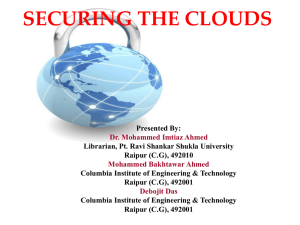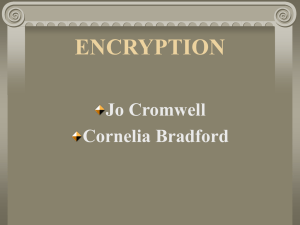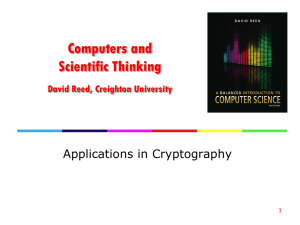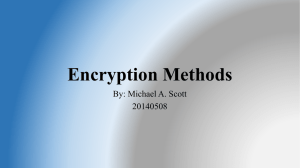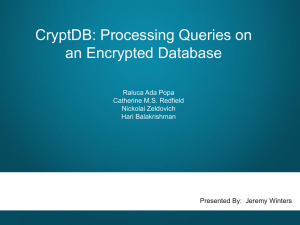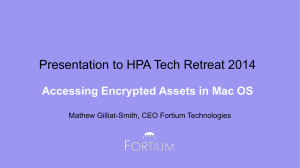Business and Trade in the Digital Age
advertisement
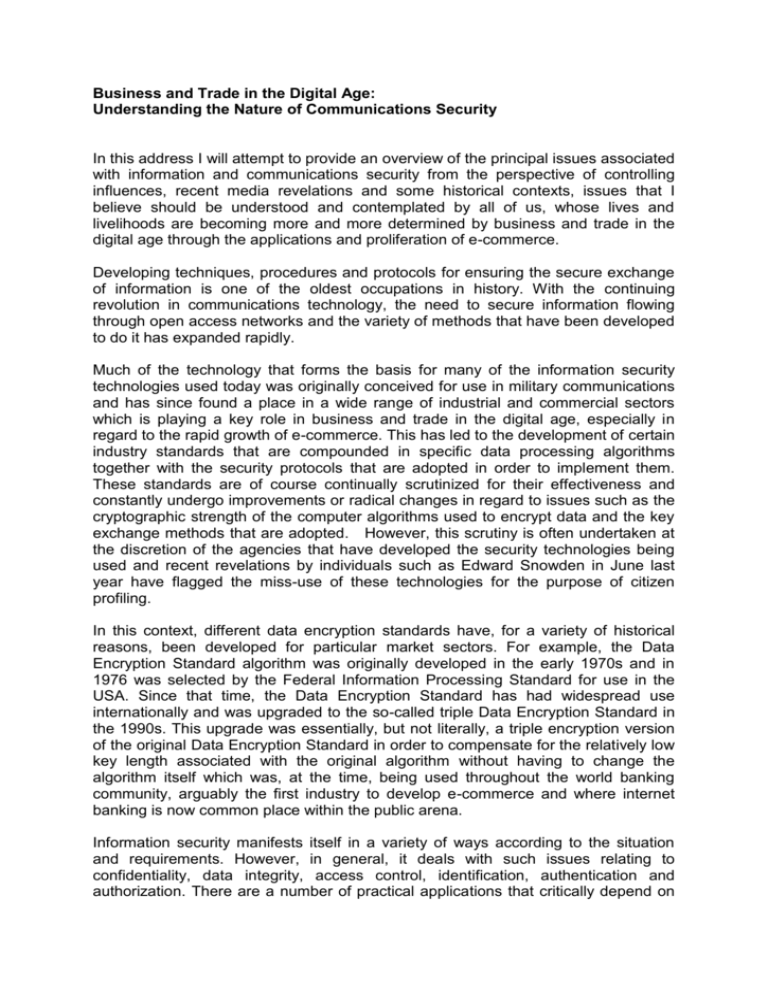
Business and Trade in the Digital Age: Understanding the Nature of Communications Security In this address I will attempt to provide an overview of the principal issues associated with information and communications security from the perspective of controlling influences, recent media revelations and some historical contexts, issues that I believe should be understood and contemplated by all of us, whose lives and livelihoods are becoming more and more determined by business and trade in the digital age through the applications and proliferation of e-commerce. Developing techniques, procedures and protocols for ensuring the secure exchange of information is one of the oldest occupations in history. With the continuing revolution in communications technology, the need to secure information flowing through open access networks and the variety of methods that have been developed to do it has expanded rapidly. Much of the technology that forms the basis for many of the information security technologies used today was originally conceived for use in military communications and has since found a place in a wide range of industrial and commercial sectors which is playing a key role in business and trade in the digital age, especially in regard to the rapid growth of e-commerce. This has led to the development of certain industry standards that are compounded in specific data processing algorithms together with the security protocols that are adopted in order to implement them. These standards are of course continually scrutinized for their effectiveness and constantly undergo improvements or radical changes in regard to issues such as the cryptographic strength of the computer algorithms used to encrypt data and the key exchange methods that are adopted. However, this scrutiny is often undertaken at the discretion of the agencies that have developed the security technologies being used and recent revelations by individuals such as Edward Snowden in June last year have flagged the miss-use of these technologies for the purpose of citizen profiling. In this context, different data encryption standards have, for a variety of historical reasons, been developed for particular market sectors. For example, the Data Encryption Standard algorithm was originally developed in the early 1970s and in 1976 was selected by the Federal Information Processing Standard for use in the USA. Since that time, the Data Encryption Standard has had widespread use internationally and was upgraded to the so-called triple Data Encryption Standard in the 1990s. This upgrade was essentially, but not literally, a triple encryption version of the original Data Encryption Standard in order to compensate for the relatively low key length associated with the original algorithm without having to change the algorithm itself which was, at the time, being used throughout the world banking community, arguably the first industry to develop e-commerce and where internet banking is now common place within the public arena. Information security manifests itself in a variety of ways according to the situation and requirements. However, in general, it deals with such issues relating to confidentiality, data integrity, access control, identification, authentication and authorization. There are a number of practical applications that critically depend on information security measures which include private messaging, encrypting email attachments, for example, financial transactions and a host of online services. All such applications relating to information security require the study of specific digital processing techniques and the design of computational methods which are compounded in the study of cryptography. This includes, not only the design of new approaches, but continual analysis with regard to validating the strengths and weaknesses of a cryptographic algorithm and the way in which it is implemented in practice. Cryptography is the study of systems that typically originate from a consideration of the ideal circumstances under which secure information exchange is to take place. It involves the study of cryptographic systems but also the possible processes that might be introduced for breaking the output of such systems - cryptanalysis. This includes the introduction of formal methods for the design of a cryptosystem and for estimating its theoretical level of security. However, in reality, a cryptosystem often forms just part of a complex infrastructure involving users that are prone to levels of both incredible ineptitude and brilliance that cannot be easily classified. Hence formalising the strength of a cryptosystem is a necessary but not a sufficient requirement for the system to be acceptably secure. Irrespective of the method of encryption that is adopted, all encrypted information raises a ‘flag' to the possible importance of the information that it conveys. For this reason it is of significant value if encrypted information can be hidden in some way in other data types in order to disguise the fact that it exists. This is known as Steganography and is starting play a significant role in e-commerce security. It is not the level of encryption that counts alone but the degree to which encrypted data can be hidden that is driving the development of security systems in today’s environment. In the ideal case, the cryptographic strength of an algorithm and its implementation method can be checked by means of proving its resistance to various kinds of known attacks. However, in practice, this does not mean that the algorithm or its specific application is secure because other unknown attacks may exist. For this reason, the security of a cryptosystem is often based on knowledge of its working legacy and the confidence level that a community has acquired from its continual use over many years through various up-grades, additions and modifications as have been considered necessary. Thus, modern systems for securing information exchange are often based to a large degree on past legacies associated with the performance and reliance of relatively well established techniques. This reality is a fundamental weakness, a weakness that is consistently miss-understood throughout history and one that has more to do with human frailty than the technology of the time. The inherent belief in the ‘power of the encrypted word’ is one of the principal reasons why secure communications have been compromised in the past and why, for all the radical developments in the digital technology we use today, mistakes are continuously made. I will explain this in a historical context later on when I revisit the mistakes made by both the allies and the axis powers during the Second World War and the effect of this in the immediate aftermath that directs the nature of communications security today. This is to say that the recent revelations of the extent to which security organisations listen into to our conversations, encrypted or otherwise is nothing new. The methods and reasons for this global snooping were developed during the cold war and were the key to it not becoming a hot war. The Communications Technology revolution associated with the latter part of the Twentieth Century has brought about a number of changes in the way we operate on a routine basis. One of the most significant of these changes is the impact upon basic human activities such as decision making, information processing and knowledge management. Business communities and government organisations rely heavily on exchanging, sharing and processing information to assist them in making a variety of strategic decisions and a wide range of security infrastructures have been established to help protect and preserve the integrity of information flowing across different channels. At a government level, knowledge of public opinion allows politicians to react rapidly in their policies or programmes at least in those cases where the infrastructure of society is based on democratic principles. In the commercial sector, ‘know how' contributes considerably to company market value because information is a primary competitive advantage. Information is now a key factor in decision making for all organisations, whatever their size and complexity, and is arguably the most important asset of an organisation. The data transferred between different locations and recipients can therefore become vulnerable to being intercepted and altered by a capable and interested eavesdropper, and information exchange through the application of a secure infrastructure has, therefore, become an essential component in all forms of knowledge management. In other words, `knowledge is power' and since all power must be contained, it is necessary to provide continuous improvements to securing information in order to maintain parity with the pace and growth of communication technology in general. The practical realities associated with information security are indicative of the fact that ‘Security is a process, not a product'. Whatever the sophistication of the ‘security system’ being used, unless the user adheres strictly to the procedures and protocols designed for its use, the system can be severely compromised. A well-documented example of this is the use of the Enigma cipher by the axis powers during the Second World War. It was not just the `intelligence' of the `code breakers' of StationX at Bletchley Park in England that allowed the allies to break many of the Enigma codes but the `irresponsibility' of the way in which the system was used by the axis powers armed forces and intelligence agencies at the time. The basic mechanism for the Enigma cipher, which had been developed as early as 1923 by Artur Schubius for securing financial transactions, was well known to the allies thanks to the efforts of the Polish Cipher Office at Poznan in the 1930s and the distribution of some 10,000 similar machines worldwide. Coupled with an innate belief in the system and the combinatorial power of the Enigma Ciphers the code breakers job was made possible through a mixture of the enemy making fundamental mistakes in the use of the system and the allies attempts to encourage them to do so more effectively. Crucial to this effectiveness was a principle called ‘Gardening’ in which the enemy was encourage to encrypt specific words and phrases through reporting on military operations that were apparently futile but through the reports transmitted and intercepted, provided the code breakers with a critical mass of known plaintexts or Cribbs in order to launch an attack. In this context and in regard to information security and knowledge management in general, there are some basic concepts that are easy to grasp but sometimes tend to get lost in the detail. The first of these is that the recipient of any encrypted message must have some form of a priori knowledge on the method (the algorithm for example) and the operational conditions - the keys - used to encrypt a message. Otherwise, the recipient is in no better `state of preparation' than the potential attacker. The conventional approach is to keep this a priori information to a minimum but in such a way that it is critical to the decryption process. Another important reality is that in an attack, if the information transmitted is not deciphered in good time, then it may become redundant. Coupled with the fact that an attack usually has to focus on a particular criterion, a specific algorithm, for example, or the ‘known algorithm attack’ which is one of the most common attack scenarios, one way to enhance the security of a communications channel is to continually change the encryption algorithm and encryption processes offered by the technology available although is easier said than done. As briefly mentioned earlier, another approach is to disguise or camouflage the encrypted message in what would appear to be `innocent' or `insignificant' data such as a digital photograph, a music file or both. Given that we now live in a communications environment that is filled with the exchange of multi-media data the potential of implementing Steganographic technologies is high. This includes the introduction of information security products themselves which are often distributed in such a way as to reflect their apparent insignificance in terms of both public awareness and financial reward. This is of course contrary to the dissemination of many encryption systems, a process that is commonly perceived as being necessary for business development through the establishment of a commercial organisation, international patents, the distribution of marketing material, elaborate and sophisticated websites and authoritative statements on the strength of a system to impress potential customers. Thus, a relatively simple but often effective way of maintaining security with regard to the use of an encryption system is to not tell anyone about it. The effect of this can be enhanced by publishing other systems and products that are designed to mislead the potential attacker. In this sense, information security products should be treated in the same way as many organisations treat a breach of security and not to disclose the breach in order to avoid embarrassment and loss of faith by the client base. A classic case of historical importance of not `keeping it quiet', was made by Winston Churchill when he published his analysis of the First World War. Churchill was always prone to having a big mouth and was told so on countless occasions including, when in 1900, he gave a speech on the stairs of the post-office here in Durban after his escape from captivity in Pretoria during the Anglo-Boer war. In his book The World Crisis 1911-1918 published in 1923, he stated that the British had deciphered the German Naval codes for much of the war as a result of the Russians salvaging a code book from the small cruiser Magdeburg that had ran aground off Estonia on August 27, 1914. The code book was passed on to Churchill who was, at the time, the First Sea Lord. This helped the British maintain their defences with regard to the Imperial German Navy before and after the Battle of Jutland in May, 1916 which forged the policy of unrestricted submarine warfare. In turn, this led to an event, namely, the sinking on May 7, 1915 of the Lusitania, torpedoed by the submarine U-20, that galvanized American opinion and played a key role in the United States' later entry into First World War on April 17, 1917. Churchill's publication did not go unnoticed and consequently significant efforts were made to develop new encryption devices for military communications. This resulted in the famous Enigma machine mentioned earlier and an interest in cryptography that was undoubtedly stimulated by Churchill's indiscretions including the establishment of the world’s first specialist cipher school in Berlin. Ironically, it was at this school that many of the Polish mathematicians were trained who later worked for the Polish Cipher Office and developed the principal mechanism for attacking the codes whose electronic version developed, in 1943 by the British post-office engineer Thomas Flowers, was the world’s first programmable computer. After the Second World War, Winston Churchill made sure that he did not repeat his mistake, and what he referred to as his `Ultra-secret' - the code breaking activities undertaken at Station X in Bletchley Park, England - was ordered by him to be closed down and the technology destroyed soon after the end of the war. Further, Churchill never referred to his Ultra-secret in any of his publications post 1945. Those personnel who worked at Bletchley Park were required to maintain their silence for some fifty years afterwards and some of the activities at Bletchley Park remain classified to this day. However, the type of work undertaken there in the early 1940s continues in many organisations throughout the world such as the Government Communications Head Quarters based at Cheltenham in England where a range of `code making' and `code breaking' activities continue to be developed. With regard to the issue of `keeping it quiet' there is one last intriguing and historically important issue which relates to the allied approach for managing the users of encryption systems and the systems themselves after the end of the Second World War in the late 1940s and 1950s, an approach that has come to dominate the management of encryption systems by authorities worldwide and directly affects us today. As the allies advanced into West Germany, many thousands of Enigma machines were captured and stock-piled. An issue arose as to what to do with them. Two options were available: first to destroy them, second to make good use of them. The latter decision was taken and coupled with a `spin' on the quality of axis wartime technologies, many Enigma machines were sold on to various governments worldwide in order to gather intelligence. However, the `key' to this deception was to maintain a critical silence on the fact that the codes generated by the Enigma cipher and variations thereof could be broken which is the `real reason' as to why the activities of `Station X' had to remain secrete for such a significant length of time. Although encryption technologies have improved radically since the development of Enigma, the management of these technologies has not. The broad strategy is to encourage the use of an encryption standard, including management of the keys that is known and preferably designed by the very authorities whose principal job is to gather intelligence associated with communications traffic that has been encrypted using the same encryption standard. This strategy has become a central theme in the management of encryption systems worldwide. It is a strategy that can only be fully compromised through the development of novel encryption methods that do not conform to a `standard'. The historical example given earlier clearly illustrates the importance of maintaining a level of secrecy when undertaking cryptographic activities. It also demonstrates the importance of not publishing new algorithms, a principle that is at odds with the academic community; namely, that the security of a cryptosystem should not depend upon algorithm secrecy. However, this has to be balanced with regard to the dissemination of information in order to advance a concept through peer review, national and international collaboration. Taken to an extreme, the secrecy factor can produce a psychological imbalance that is detrimental to progress. Some individuals like to use confidential information to enhance their status. In business, this often leads to issues over the signing of Non-Disclosure Agreements, for example, leading to delays that are of little value, especially when it turns out that there is nothing worth disclosing. Thus, the whole issue of `keeping it quiet' has to be implemented in a way that is balanced, such that confidentiality does not lead to stagnation in the technical development of an information security system. The public awareness and development of information security technology in regard to the growth of e-commerce is one of the most interesting challenges for business and trade in the digital age. As more and more members of the younger generation become increasingly information technology literate, it is inevitable that a larger body of perfectly able minds will become aware of the fact that cryptography is not as difficult and demanding as they have been led to believe by their peers. As with information itself, the days when cryptography was in the hands of a select few with impressive academic credentials and luxury civil service careers are over and cryptosystems can now be developed by those with a diverse portfolio of backgrounds which does not necessarily include a University education. This is reflected in the fact that after the Cold War, many defence organisations worldwide developed a strategy for developing products driven by commercially available systems. This ‘Commercial-Off The-Shelf’ approach to defence technology has led to the downsizing of the Scientific Civil Service in many countries, a service that, during the Cold War, was a major source of scientific and technical innovation. The average graduate of today can rapidly develop the ability to design an encryption system which, although relatively simple, possibly trivial and ill-informed, can, by the very nature of its non-compliance to international standards, provide surprisingly good security. This can lead to problems with the control and management of information when increasingly more individuals, groups, companies, agencies and nation states decide that they can ‘go it alone' and do it themselves. This is the very same principle that Mohandas Ghandi, who arrived in Durban in 1893 to practice law, considered when he introduced the homespun movement designed to break the British textiles monopoly in the 1930s. While each homespun encryption system may be relatively weak, compared to those that have had expert development over many years, have been well financed and been tested against the very best of attack strategies, the proliferation of such systems is itself a source of significant difficulty for any authority whose role is to monitor communications traffic in a way that is timely and cost effective. This is why agencies prefer to preside over an infrastructure in which everyone else is confidently reliant for their information security, on products that have been developed by the very authorities that have encouraged their sale and distribution. By way of an example, in 2000 the United Kingdom introduced the Regulation of Investigatory Powers Act which included legislation concerning the decryption of massages by a company client. In effect this meant that any company that had developed a new encryption product was liable to prosecution if it could not decrypt a client’s cipher upon request by the state, thereby forcing new companies to introduce a complex information management infrastructure requiring capital investment that precluded small start-up ventures from entering the market. In this context, and, with respect to some of my own business developments, I have had to conform to new legislation in the application of Evolutionary Computing for generating personalised ciphers using natural noise sources, an approach that has now been published in the Irish Signals and Systems Conference, 2013 in a paper entitled ‘Encryption using Evolutionary Computing’. This legislation is another reason why I co-founded a new Journal of Theoretical Physics and Cryptography in 2010 where I am Editor-in-Chief, a Journal that focuses on the rapid turnaround of open access publications and whose editorial board includes fellow academicians from India, China and Russia. In a game such as chess, for example, there is no such thing as a perfect game other than the game itself, at least, for chess enthusiasts. Such games are based on a set of pre-defined rules. All games of this type are intrinsically dynamic processes; they change according to the game plans perceived to be in the mind of opponent; plans that are themselves in a constant state of flux. Real games were first conceived in terms of organized systems by the French Mathematician Emile Borel in the early 1920s and the idea developed further by the Hungarian Born mathematician, John Von Neumann in his theory of games developed in the 1940s. These are the sort of games that humans play and are not necessarily based on a set of pre-defined rules. They are games where the game itself is an intrinsically dynamic process, forever evolving according to the games perceived to be in the mind of opponent. If there can be such a thing as a ‘golden rule' for games, dynamic or otherwise, then it is this: ‘Never underestimate the enemy’. This includes appreciating that a clever invention or tactic or both could have been anticipated by the opponent and have been developed and implemented a priori. Good security processes are based on products, procedures and protocols that are dynamic and the security industry is best composed of individuals that, like great chess players, have two things in common: a detailed and near-photographic memory of previous games they have played and won or lost; a completely detached and analytical view of these games, and, above all, a healthy cynical attitude with regard to their value. Thus, in regard to the issue of ‘playing the game for the game's sake', information security is best undertaken by changing the characteristics of the game itself. This approach needs to realised within the context that gaming is valid at many scales, from the sociopolitical arena to the level of technical innovation. Further, the nature of the games play is such that there is usually an intrinsic self-similarity associated with the framework in which the games are played, that is to say, the games are scale invariant. Some of the most innovative ideas in information security with regard to changing the ‘game' are the simplest. For example, after the Second World War, as the cold war developed, although the Union of Soviet Socialist Republics did not have complete knowledge of the code breaking activities of the other allies, it was well known that these code activities had been based on information retrieved by intercepting wireless-based communications – wireless encrypted Morse Code. For the authorities in Moscow, the answer was simple. They used land lines until they felt confident of their own wireless-based cryptosystems. This was not an elegant solution but it was simple and highly effective and literally kept the North Atlantic Treaty Organisation in the dark for decades to come with many attempts being made by the western powers to physically intercept or tap the USSR `land-lines' with little success. In conclusion, the proliferation of homespun encryption systems that are designed and used by informed individuals and organisations is not only possible but inevitable, an inevitability that is guided by the principle that if you want to know what you are eating then you should cook it yourself. Security issues of this type have become the single most important agenda for future government policy on information technology, especially when such systems have been ‘homespun' by those who have learned to fully respect that they should, in the words of Shakespeare, ‘Neither a borrower, nor a lender be’ and never fail to remember that ‘the very walls have ears’. For as the American journalist and commentator on homeland security, Vincent McLellan, says in his book ‘A Thinking Man’s Creed for Cryptography’, Cryptography is like literacy in the Dark Ages. Infinitely potent, for good and ill, yet basically an intellectual construct, which by its nature will resist efforts to restrict it to bureaucrats and others who deem only themselves worthy of such privilege. J M Blackledge 9 March, 2015
